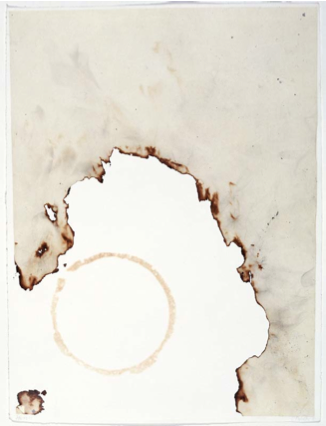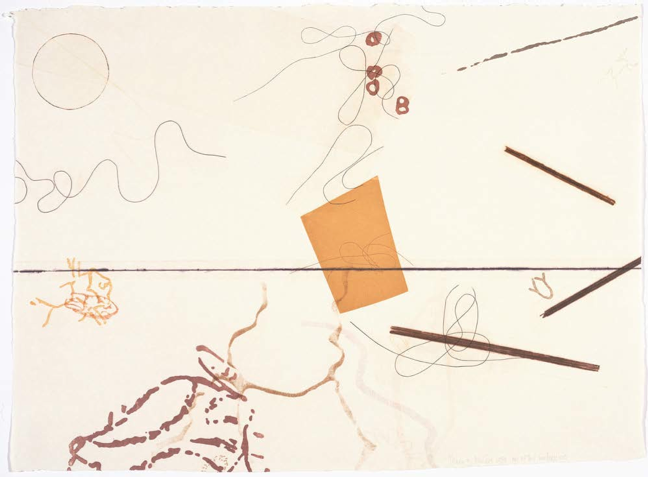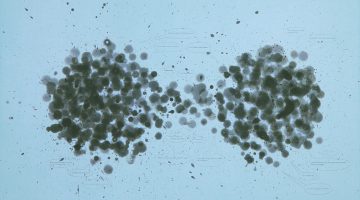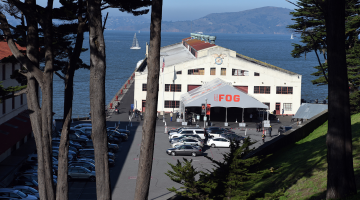The following is an excerpt from the third and final chapter of my book Logro, Fracaso, Aspiración: Tres Intentos de Entender el Arte Contemporáneo (2014). The book is based on three lectures I gave at the Universidad de los Andes in Bogotá in the spring of 2009. A major part of the project of the lectures was to sketch some considerations concerning distinctive characteristics of achievement and failure in contemporary art. In the last lecture I turned to the question of what one might hope for from contemporary art, and how the aspiration adopted by an artist shapes and places stringencies upon his or her work. The central analysis I gave was of some of the late work of John Cage, in particular the stunning prints he made yearly at Crown Point Press in San Francisco from the late 1970s until his death in 1992.
I conceived of this selection, and the book generally, as an instance of philosophy whose chief characteristics are diagnostic and aspirational. By “diagnostic” I mean something like what the philosopher Hans Sluga has recently put forth with regard to political philosophy: the work begins with a sense of unease and aims to characterize the source of that unease. No attempt is made to be comprehensive, nor to produce anything relating to alleged timeless or eternally valid aspects of the subject. By “aspirational” I mean that the analysis is oriented to suggest a sense of possibility, of how the existing state of affairs might be opened up, re-thought, re-worked, and re-oriented towards worthwhile ideals. In line with these two characteristics, I tried to show how Cage’s visual works revealed to Cage himself a kind of dogmatism within his earlier celebrated and notorious musical composition, one wherein he had incorporated a poetics still expressive of productivist metaphors and conceptions; in response, and through great personal difficulty, he was able to invent a new conception of an ecological art. Both characteristics of this philosophy, the diag- nosis and the sense of possibility, are shown to also be aspects of a contemporary art practice:
One of the most recent and most insistent demands that has arisen within the arts is the demand for a “green” art, which also goes by the name of environmental or ecological art. What is distinctive about this art, which I shall call “ecological”? It seems that a conception of such art has arisen in recent decades and become stabilized. Such an art would (a) involve primarily “local” materials, where local means something like what is available without strenuous use of advanced technologies within an ecological region, or a “place” defined by what is regularly perceived of and used by those who have lived there for more than a generation; (b) the work must be in some sense a response to the place, and to what is distinctive about the place; (c) that the work would thereby carry a symbolic meaning, one of a piece with the sense that it is part of a kind of production or culture that offers an alternative to those kinds of production and culture expressive of capitalism’s sublime powers of destruction, or of the project of mastering nature; (d) the work, as well as the activities involved in making and appreciating the work, must have one or more of a certain highly marked temporal character: (i) something suggestive of evanescence or ephemerality, and often carrying a further quality of fragility; (ii) a sense that the artifact has so to speak a future after its current use; it can be folded into a future use, or recycled; (iii) making and/or appreciating the work have a custodial sense, or conserve something valuable or precious; (e) that the guiding spirit of these works, insofar as they arise in Western culture, is Orpheus (as in Rilke’s “it’s Orpheus when there’s music”), and not Prometheus; (f) and that the fundamental aim of these works is to initiate, foster, maintain, etc., the spirit of “place,” where place is opposed to space, a kind of homogeneous continuum of extension. So the function of the model is aspirational: works made in accordance with it aim to provide the viewer or participant an experiential sense of what it is like to inhabit a place, and to foster the sorts of virtuous responses that would be part of the habitual responses of those who live in “places,” as opposed to “spaces” . . .
John Cage was one of the very greatest artists of recent times to have confronted these questions [surrounding the nature of ecological art]. Or so I shall claim. Cage is usually thought of as an experimental composer, though he preferred to be thought of as an inventor, and one might add an inventor of genius. He is of course best known as the “inventor” of techniques for the use of chance in musical composition. In the late 1970s, around the age of 65, he was invited by Kathan Brown, the director of Crown Point Press, to visit the press and use their printmaking facilities to make visual artworks. Cage, recalling one of a few dozen autobiographical stories he used countless times to render his artistic intentions intelligible, claims to have hesitated to accept, because in his early twenties he had promised Arnold Schoenberg that he would dedicate his life to music if Schoenberg would teach him composition. But he also recalled his great regret at having turned down an invitation in the late 1940s from Rita Sarabhai to trek northern India and Nepal. So he decided that he would accept Brown’s invitation, and that if he made visual works with the same techniques he used to compose, he would also be keeping his promise to Schoenberg. These same techniques would be the use of chance in selecting the elements and their arrangement in his visual works. Brown has provided detailed accounts of Cage’s experimenting with etching and printmaking, and has suggested that the culmination and greatest achievement of his first five years at Crown Point is the series Déreau, a portmanteau title from “derive” and “Thoreau.” But Brown has also described how the year after Cage made the Déreau series, when he returned to Crown Point Press, he abandoned the ways in which he had worked, and began over with different techniques. He began with attempts to work the paper directly, and in ways that were suggestive of violence: he crumpled it, stained it with tea and coffee, even ran over it (perhaps a reminiscence of the work he had done with Rauschenberg in the early 1950s). Cage fell into despair, characterized by a lengthy depression in which he claimed that his entire life’s work was a failure. Finally, he treated the paper with fire, smoking it and burning it, and applied heated circular brands from salvaged car parts. He declared himself satisfied, his depression lifted, and for the rest of his life enjoyed his yearly trips to the Press…
In viewing the complete set of Cage’s Déreau a number of times in early 2001 at the Legion of Honor in San Francisco, I was struck by a certain fantasy: that the elements of the work, the various bits of drawing taken from the notebooks of Thoreau, seemed to slide across the paper, as if flowing from upper left to lower right. As one scans the works one notices the recurrence of elements (the little waterbug is particularly striking) and registers quickly their different placements, colors, and saturations of color. One senses that the elements and the paper are of two different pictorial orders (foreground versus background and/or support). One thereby gains a vivid sense of the contingency of the elements’ sheer occurrence, as well as their placement. Now this, I suggest, is what one cannot gain from the performed results of chance procedures in music. For in the unfolding of a piece of music, the occurrence of an element, a sound event, is fused with the moment of its occurrence: it is this-sound-at-this-time. Sound and moment form a qualitative unity. And this is part of the point of the use of chance procedures in music: to defeat the listener’s sense of expectation, that one event or kind of event will follow another or another kind, in order to make the listener’s mind “susceptible to divine influences.”
But the viewer (as opposed to a listener) of a series of works resulting from chance techniques can scan the works, which involves operations of noticing, itself presupposing the operation of short-term memory in noting identities, resemblances, etc. But then the mind of the viewer cannot be thought of as wholly attuned to a (simple) moment. And in a way only perhaps loosely analogous with this, once one notices the difference of order between elements and support, one grasps that the looking solicited by the visual artworks is one that is indefinitely extended temporally, as it involves the perceptual and imaginative exploration of relations among elements and their support, in addition to viewing across works. In the visual works a perceptual sense of contingency is realized, but not, in contrast to the musical works, one which supports the fantasy of an “immediate” or simple present. And this recognition reflects back upon the musical works, wherein the use of chance techniques is revealed as presupposing a similar hidden heterogeneity: between the activity of deciding upon the time-space continuum which will count as (the container of) the work, and the phenomenal events that make up the perceptually available elements of the piece, and which arise out of the application of impersonal chance mechanisms.
Some of you will find this account fanciful. But it helps explain two points that are unintelligible on Brown’s interpretation: why did Cage say in despair that his whole life’s work was a mistake (and not just that he couldn’t make satisfactory visual works), and why did he abandon the conception that resulted in Déreau and immediately begin by working the support with elemental forces and with a vehemence that suggests violence upon the support? What is distinctive about the works Cage made, the Smoked series, is that it is the very same elemental force, heat, that marks the paper from within or from underneath, causing it to blossom, and from without or above, leaving the circular brands. The use of the same force unifies the treatment of the surface and the applica- tion of marks, and so lessens the sense that two separate orders are coming into contact with each other, and in a way that does not allow them to interpenetrate or to share the same substance. Here, then, as [the social philosopher Theodor] Adorno might have put it, is an artwork that non-violently unifies a sensuous manifold. And, finally, in a further series, Ryoanji, where Cage uses a brush to outline stones, the sense that application of the paint and its inherence in the support are of distinct orders has subsided. It is worth noting that Cage, in his late music of the so-called number pieces, directs that the sounds seem “brushed” into existence. The metaphor forged in the resolution of the fantasy of violence in the visual works is applied now mutatis mutandis to the musical works.

John Cage, Eninka #42, 1986. One from a series of 50 smoked paper monotypes with branding on gampi paper chine collé. 241⁄2 x 181⁄2 in. Published by Crown Point Press.
Without an appreciation of not just Cage’s aims, but also of the motivations for those aims, it would be even more difficult to understand why Déreau failed—that is, failed artistically as a satisfying expression of an eco-poetics. In the later work Cage has resolved in practice one part of the tension implicit in the multi-faceted model of an eco-poetics. The resultant works are certainly expressive of ephemerality and fragility. The artist and viewer share the stance of a custodian of the moment. But what of the other characteristic of a highly marked temporality, the sense that the work has a future of being folded in or recycled? Here one must search. It is hard to see how the custodial model could be reconciled with folding in. But perhaps one has to look more broadly. One highly marked aspect of the appearance of the works is that they have, after all, been subjected to some great force, even if the sense of the force working both within and without the paper relieves some of the threat of violence. The work seems to have survived something, and what is left is something that has to that extent passed a test; a test of such severity that it threatened to consume it. A final thought, and one which not everyone will be prepared to follow, is that what has survived has shown itself to be valuable, and therefore worthy of loving custodial care. So what remains is not (yet) to be recycled. The value of folding in is honored, but not everything is ready just yet to be used in some other configuration.
At a very general level, we might expect the ambition of an eco-poetics to be the great demand regulating art in the 21st century, as the great demand in the 20th century was for political art.



